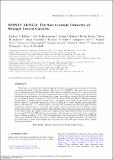Files in this item
SDSS-IV MaNGA : the spectroscopic discovery of strongly lensed galaxies
Item metadata
| dc.contributor.author | Talbot, Michael S. | |
| dc.contributor.author | Brownstein, Joel R. | |
| dc.contributor.author | Bolton, Adam S. | |
| dc.contributor.author | Bundy, Kevin | |
| dc.contributor.author | Andrews, Brett H. | |
| dc.contributor.author | Cherinka, Brian | |
| dc.contributor.author | Collett, Thomas E. | |
| dc.contributor.author | More, Anupreeta | |
| dc.contributor.author | More, Surhud | |
| dc.contributor.author | Sonnenfeld, Alessandro | |
| dc.contributor.author | Vegetti, Simona | |
| dc.contributor.author | Wake, David A. | |
| dc.contributor.author | Weijmans, Anne-Marie | |
| dc.contributor.author | Westfall, Kyle B. | |
| dc.date.accessioned | 2018-03-13T15:30:09Z | |
| dc.date.available | 2018-03-13T15:30:09Z | |
| dc.date.issued | 2018-03-10 | |
| dc.identifier | 252533919 | |
| dc.identifier | dc59c3e1-6163-413f-b303-894f37c2776f | |
| dc.identifier | 85046699176 | |
| dc.identifier | 000432660300015 | |
| dc.identifier.citation | Talbot , M S , Brownstein , J R , Bolton , A S , Bundy , K , Andrews , B H , Cherinka , B , Collett , T E , More , A , More , S , Sonnenfeld , A , Vegetti , S , Wake , D A , Weijmans , A-M & Westfall , K B 2018 , ' SDSS-IV MaNGA : the spectroscopic discovery of strongly lensed galaxies ' , Monthly Notices of the Royal Astronomical Society . https://doi.org/10.1093/mnras/sty653 | en |
| dc.identifier.issn | 0035-8711 | |
| dc.identifier.other | BibCode: 2018arXiv180303604T | |
| dc.identifier.other | ORCID: /0000-0002-5908-6852/work/42734901 | |
| dc.identifier.uri | https://hdl.handle.net/10023/12931 | |
| dc.description | Funding: Leverhulme Trust Early Career Fellowship (AW). | en |
| dc.description.abstract | We present a catalogue of 38 spectroscopically detected strong galaxy-galaxy gravitational lens candidates identified in the Sloan Digital Sky Survey IV (SDSS-IV). We were able to simulate narrow-band images for 8 of them demonstrating evidence of multiple images. Two of our systems are compound lens candidates, each with 2 background source-planes. One of these compound systems shows clear lensing features in the narrow-band image. Our sample is based on 2812 galaxies observed by the Mapping Nearby Galaxies at APO (MaNGA) integral field unit (IFU). This Spectroscopic Identification of Lensing Objects (SILO) survey extends the methodology of the Sloan Lens ACS Survey (SLACS) and BOSS Emission-Line Survey (BELLS) to lower redshift and multiple IFU spectra. We searched ∼1.5 million spectra, of which 3065 contained multiple high signal-to-noise background emission-lines or a resolved [O ii] doublet, that are included in this catalogue. Upon manual inspection, we discovered regions with multiple spectra containing background emission-lines at the same redshift, providing evidence of a common source-plane geometry which was not possible in previous SLACS and BELLS discovery programs. We estimate more than half of our candidates have an Einstein radius ≳ 1.7”, which is significantly greater than seen in SLACS and BELLS. These larger Einstein radii produce more extended images of the background galaxy increasing the probability that a background emission-line will enter one of the IFU spectroscopic fibres, making detection more likely. | |
| dc.format.extent | 2225112 | |
| dc.language.iso | eng | |
| dc.relation.ispartof | Monthly Notices of the Royal Astronomical Society | en |
| dc.subject | Galaxies: general | en |
| dc.subject | Gravitational lensing: strong | en |
| dc.subject | QB Astronomy | en |
| dc.subject | QC Physics | en |
| dc.subject | DAS | en |
| dc.subject.lcc | QB | en |
| dc.subject.lcc | QC | en |
| dc.title | SDSS-IV MaNGA : the spectroscopic discovery of strongly lensed galaxies | en |
| dc.type | Journal article | en |
| dc.contributor.sponsor | The Leverhulme Trust | en |
| dc.contributor.institution | University of St Andrews. School of Physics and Astronomy | en |
| dc.identifier.doi | https://doi.org/10.1093/mnras/sty653 | |
| dc.description.status | Peer reviewed | en |
| dc.identifier.url | http://adsabs.harvard.edu/abs/2018arXiv180303604T | en |
| dc.identifier.grantnumber | ECF-2014-767 | en |
This item appears in the following Collection(s)
Items in the St Andrews Research Repository are protected by copyright, with all rights reserved, unless otherwise indicated.

